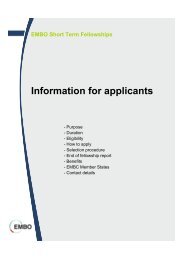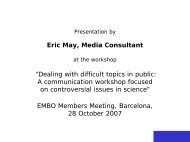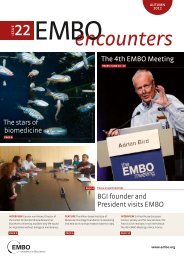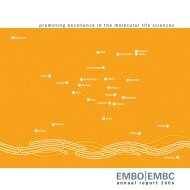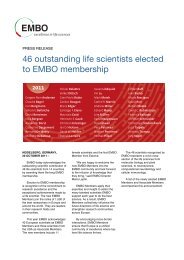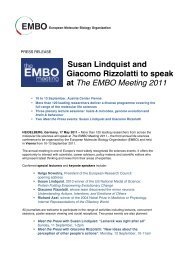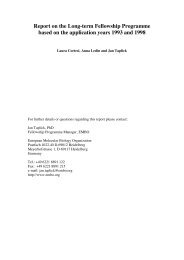EMBO Fellows Meeting 2012
EMBO Fellows Meeting 2012
EMBO Fellows Meeting 2012
You also want an ePaper? Increase the reach of your titles
YUMPU automatically turns print PDFs into web optimized ePapers that Google loves.
Jens Fritzenwanker<br />
<strong>EMBO</strong> <strong>Fellows</strong> <strong>Meeting</strong> <strong>2012</strong><br />
Evolution of the bilaterian trunk; insights from the unsegmented hemichordate<br />
Saccoglossus kowalevskii<br />
Abstract<br />
My current research focuses on the mechanisms underlying the development of the bilaterian trunk and its<br />
evolution. In contrast to non-bilaterian animals, such as cnidarians, bilaterians have an anteroposterior (AP)<br />
axis that is divided into two major regions; the head and the trunk. How mechanisms of trunk development<br />
arose at the base of the bilaterians is not clear, and comparative data are sparse. All bilaterians investigated so<br />
far are animals with segmented body plans, which have posteriorly-localized, terminal growth zones from<br />
which tissue is subsequently added to the elongating AP axis. In these animals posterior growth is always<br />
linked to segmentation, which makes these two mechanisms difficult to study independently. This linkage has<br />
further led to the hypothesis that posterior growth and segmentation evolved together at the base of all<br />
bilaterians, which supports the hypothesis that mechanisms of segmentation are homologous between<br />
protostomes and deuterostomes. However, the inability to untangle mechanisms of segmentation from<br />
posterior growth makes it a challenge to reconstruct the early origins of the trunk. I therefore selected the<br />
unsegmented hemichordate Saccoglossus kowalevskii to determine what components of posterior<br />
growth/segmentation-networks shared between chordates and arthropods are uniquely involved in posterior<br />
growth. I am currently exploring these mechanisms by characterizing the gene regulatory networks regulating<br />
posterior patterning during trunk development and plan to extend my work into analyzing posterior stem cell<br />
behavior.<br />
Jens H. Fritzenwanker, Christopher Lowe<br />
Hopkins Marine Station of Stanford University, 120 Oceanview Boulevard, 93950 Pacific Grove, CA, USA<br />
14-17 June <strong>2012</strong>, Heidelberg, Germany




